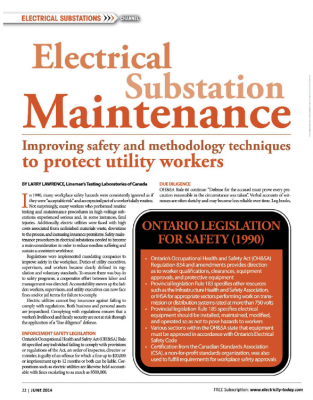LTL Blog
Lineman's Testing Laboratories of Canada
Ensuring Electrical Sa...
Ensuring the Integrity...
Tips for safety when w...
7 Benefits to Using Gr...

This article originally appeared in the June 2014 issue of Electricity Today.
Not long ago, many workplace safety hazards were consistently ignored as if they were “Acceptable Risk” and an expected part of a worker’s daily routine. Not surprisingly, many workers experienced serious and, in some instances, fatal injuries. Companies were also faced with high costs associated from unfinished materials waste, downtime to the process, and increasing insurance premiums. Safety in the workplace needed to become a main consideration in order to reduce needless suffering and sustain a consistent workforce.
Regulations were implemented mandating companies to improve safety in the workplace. Duties of owners, supervisors and workers became clearly defined. To ensure there was buy-in to safety programs, a co-operative effort between labour and management was directed. Accountability runs up the ladder; workers, supervisors and owners could now face fines and/or jail terms for failure to comply.
You can’t buy insurance against failing to comply with regulations. Both business and personal assets are jeopardized. Complying with regulations ensures your livelihood and family security are not at risk through the application of a “Due Diligence” defense.
LEGISLATION FOR IMPROVED WORKER SAFETY
- OH&SA Reg. 834 and amendments has provided direction as to worker qualifications, clearances, equipment approvals, protective equipment
- Rule 183 specifies other resources such as Electrical & Utilities Safety Association (now IHSA) for appropriate sectors performing work on transmission or distribution systems rated at more than 750 volts
- Rule 185 specifies electrical equipment shall be installed, maintained, modified and operated so as not to pose hazards to workers
- Various sections within OH&SA state that equipment must be approved in accordance with the Electrical Safety Code
- CSA certification will also fulfill requirements for approval
ENFORCEMENT OF SAFETY LEGISLATION
OH&SA Rule 66 specifies any individual failing to comply with provisions or regulations of the Act, an order of Inspector, Director or Minister, is guilty of an offence for which a fine up to $20,000 or imprisonment up to 12 months or both can be liable. Corporations are likewise held accountable with fines escalating to as much as $500,000.
DUE DILIGENCE
OH&SA Rule 66 continued: Defense for the accused must prove every precaution reasonable in the circumstance was taken. Verbal accounts of witnesses are often sketchy and may become less reliable over time. Log books, Inspection Forms and Procedural Sign-Offs, when completed properly, can be invaluable tools for recalling details of events.
RATIONALIZING SAFETY COSTS
The most obvious reason workplace hazards were ignored for so long was two-fold: 1) not knowing how to implement change; and 2), the cost involved. The old mind-set was that you couldn’t compete in the global market if you had to bear the extra costs of implementing safety measures. However, loss prevention education and experience has shown that the obvious costs of implementation are heavily outweighed by unseen cost factors plus pain and suffering associated with accidents and incidents. It is a poor business model that doesn’t include workplace safety.
Whether setting up a program for inspecting the work area or determining effectiveness of a process, you need a tool to measure and compare results. Audits can be used to identify possible modifications and evaluate equipment modernization, operation and maintenance techniques. Failure is defined as the point when equipment fails to perform according to its intended function – not simply when it stops working. An Audit form needs to be drafted for each site or process to evaluate potential risk and resources to mitigate. Resources may be as simple as providing distance from the hazard or may require complicated timing adjustments, work procedures, barriers and PPE ― but in all cases, documentation is required.
SAFETY AUDIT
As demand for improved workplace safety continued throughout the 1990s and into 2000, so did the demand for better recording and measuring devices. Audit systems were now available from numerous agencies, i.e., ISO, IHSA, various Ministries, insurance providers (e.g., FM Global), and CSA.
CSA has recently expanded their guidelines and audits to include:
Z462-12 Workplace Electrical Safety
This standard specifies requirements for workplace electrical safety necessary for the practical safeguarding of workers during activities such as the installation, inspection, operation, maintenance and demolition of electrical conductors and electrical equipment, as well as work in proximity of energized electrical equipment.
Z463-13 Guideline on Maintenance of Electrical Systems
The purpose of an electrical maintenance, Quality Maintenance System (QMS) is to:
- prevent worker injury and property damage;
- define the requirements as part of an overall QMS for the organization as a whole;
- meet or exceed applicable legislation, regulations, codes and standards;
- mitigate potential liability, insurance costs and losses;
- facilitate the selection and application of appropriate standards;
- develop strategies for the integration of electrical maintenance into existing management systems;
- integrate electrical maintenance with other maintenance plans (e.g., mechanical, building, environmental systems); and
- consider safety, reliability and maintainability as part of equipment procurement specifications and repair/rebuilding of electrical equipment.
LAST LOOK
The recommendations of the guidelines above are intended to address worker safety as the primary objective, and the protection of property and the environment as the secondary objective.
For those having little or nothing in place, the guidelines above contain reference materials, outlines of sampling plans, and basic worksheets, which can be modified to individual needs and assist in implementing a proper inspection and audit of electrical substations and the various components.
Your comment will go through an approval process and may not be visible to the public right away.


